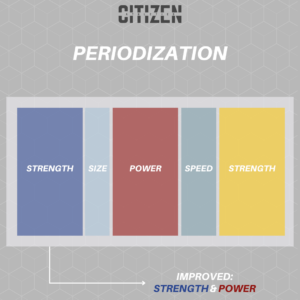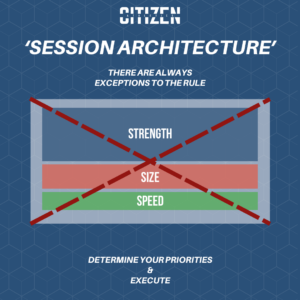KEEP THE MAIN THING, THE MAIN THING.
Training blocks, building blocks, lovers locks, who the hell knows anymore. The basics of programming, periodization, and quality training concepts have been lost in the maze of optimized potentiation effects, undulating microcycles and my personal favorite, ‘sEsSiOn aRcHiTecTuRe.’ Instead of finding a consistent training schedule that allows for adaptation, we’ve been duped to believe that we can accelerate this process by ‘bio-hacking’ our training to optimize for a perfect daily workout plan.
Today’s topic is all about the basics; Periodization, Programming, Training Blocks and more as a means to anchor our thoughts & perspectives around training goals and how we can most efficiently accomplish them. Let’s dive in:
RIPPING THE BAND-AID OFF: WHAT IS PERIODIZATION?
Ahhh yes, every coaches’ favorite mental masturbation technique; periodization.
Woah woah there, this is a FAMILY establishment. What in the HECK are you talking about?!
My apologies, for those not familiar with this uncomfortably accurate term, mental masturbation is ‘the act of engaging in useless yet intellectually stimulating conversation, usually as an excuse to avoid taking constructive action.’
There. Can you see it NOW?! Thought so.
Periodization is the term coaches use to describe long term exercise planning. It is the broad-stroked brush that sets a backdrop for what a practitioner aims to accomplish in a given period of time (most commonly on a seasonal or annual basis). With countless strategies for ‘optimization’ of ideal results, coaches often get swooned and swayed by the nuances and minutiae associated with specific periodization schemes, before they even define the qualities they want to develop in the first place!

Just like Babe Ruth pointing at the centerfield flagpole right before smacking one right into the stands, shutting down the heckling Cubs’ dugout, you have to call your shot. THAT is what periodization is; telling the world the results you’re going to provide.
Whether it’s undulating, reverse, or any other variation that the latest instagram guru is talking about these days; at its core, periodization requires you to have a keen understanding of the qualities you aim to develop for the people you work with.
But, how do you know which qualities you NEED to develop? Oh boy, here comes part 2!
WHAT THE HELL IS ‘SPORTS-SPECIFIC?!’ – UNPACKING THE ‘NEEDS’ IN NEEDS ANALYSIS:
The more frequently you say a term, the less value it really has. Just say bowl 20+ times in a row and you’ll not only be questioning if you’re even making a coherent combination of noises by the end, but you’ll be second-guessing reality itself. Okay, not really – but it sends me on a trip every time…. BOWL – weird right?
The same can be said for the term ‘sport-specific.’ Its prolific use in the rehab and strength industries has led it to be nothing more than a context-less appeal to specificity. In reality, the concepts, decisions, and interventions that practitioners implement is best to be guided by the defined components in a needs analysis. Let’s unpack that.
A Needs Analysis is a critical review of what qualities are required to be successful in a sport; this could be strength, endurance, power, flexibility or any other requisite quality you could think of that a successful athlete would possess. Rather than implementing bosu-ball burpees while someone else nominates you for the ice-bucket challenge as reaching ploy to mimic the demands of sub-zero surfing, you can instead boil such components down to qualities like shoulder endurance, trunk rotation power, and variable squat mobility demands. Seems simpler, right?

Hmm, it’s almost like those would be the qualities that better allow you to ‘call your shot’ when you begin to periodize for someone’s long term athletic development! Must be a random coincidence… ANYWAY, let’s talk about another completely random and unrelated concept.
I NEVER WANTED TO BE AN ARCHITECT
How you organize a training session has been titled ‘Session Architecture,’ likely as another ploy for online fitness coaches to puff and beat their chests, showing the world they’re smarter than just counting to three sets of ten. But, rather than repackaging the same vanilla programming and session organization, what if you just called a spade a spade?
Most coaches will organize a session based on where their priorities lay. Makes sense right? You want to ensure that you have the most energy for the movements / activities that will give you the most bang for buck. In doing so, coaches, clinicians, or anyone else responsible for writing workouts can ‘begin with the end in mind’ as they prioritize the movements that are most likely to accomplish their periodization plan, which is dictated by their needs analysis.
Simply put, find the thing you want to prioritize for that day and put it first. If you have secondary or tertiary priorities that also reasonably fit within the session, feel free to add them as you see fit. While many will say ‘Multi Joint before Single Joint’ or ‘Fast before Slow’ when it comes to session timing, there will always be exceptions to such rules. Rather than creating unnecessary, yet rigid boundaries around how you ought to structure your training, maybe you can view this process on an individual basis, as you consider the needs and goals of the athlete as they relate to your north star.

By building a session’s goals independent of the methods (aka exercises) you select, you can keep the end result in focus, while the exercises become the magnifying glass.
Now, on to the hottest take you’ll see this week:
PROGRAMMING SHOULD TAKE YOU LESS THAN 3 MINUTES PER TRAINING SESSION
Yup. I said it. If you have a process set in place and have appropriate context for the athlete’s training & competition schedule, programming should be the LEAST of your concerns.
Analyze your sport, call your shot, organize your sessions & execute. That’s it.
While it has become ‘in vogue’ to trash the idea of using ‘instagram exercises,’ as a way to increase your repertoire, or gain inspiration for exercise planning, I’ve got beef with those who are… well… beefing. I am actually a huge fan of this tactic, and think it can be helpful for countless coaches, there’s just one caveat:

You have to earn the right to do so. After breaking down each element of an overall training plan, all you have left to do is fit the puzzle pieces back together. Sure, the basics have stuck around for years because they work; but there’s nothing wrong with sprinkling variability into your training so long as it doesn’t distract from your main goals.
There are some seriously creative people out there that can provide real value, as long as you know how to use it! Being able to add exercises into your repertoire and exercise prescription process can be incredibly valuable to not only you, but those that you work with as well. Just make sure you’ve established some sort of vetting & reflection process for any exercise you choose to implement. Nobody needs to do a lunge-curl-press-squat-cruch on a bosu ball… ever.
LET’S BRING THIS HOME
At the end of the day, the beauty of training isn’t in the sophisticated ‘architecture’ of an individual session, but rather, the progress it yields for those who are dedicated to it. Rather than falling for a certain system or structure to provide the solution to all your training answers, most elite coaches know that results are made by putting in the work, day in and day out.
While new training paradigms will be helpful to add different perspectives and re-package new methods to conceptualize your training practices, these methods can only be effective when placed within a structured plan. As a coach, clinician, or someone who just enjoys writing their own workouts, it should be well understood that creating a foundation of task analyses, basic periodization principles, and simple session organization methods will be the greatest ‘bang for buck’ practice to elevate your abilities in selecting exercise.
Build a framework first. Trust me, the gaps you have to fill become much smaller.
ABOUT THE AUTHOR:

Dylan Carmody is a Doctor of Physical Therapy, and Strength & Conditioning Coach with 5+ years in the performance and rehab industries.
Having dabbled in training modalities like Olympic Lifting, Cycling, Powerlifting, and CrossFit, Dylan has a deep appreciationfor all things performance, while still having a positive and fun-loving approach to exercise.
Dylan’s coaching experience is equally eclectic, ranging from performance coaching for elite athletes in the NCAA D1 setting, to group fitness and weight loss coaching in his early career.
With detailed exercise programming & consistent communication, he aims to create a training environment that is not only ‘tolerable’ for clients’ aches and pains, but truly helps to resolve their issues in the first place.

